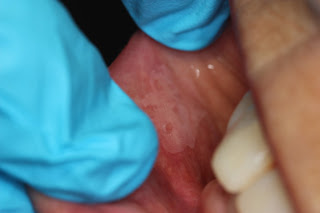A 48-year-old female presented with a white lesion on her lower labial mucosa noted during her follow-up exam in the implant clinic. The lesion was asymptomatic and the patient was unaware of it presence. The hygienist evaluating this patient recorded the dimensions as 40 X 40 mm. She also documented in her noted that the lesion appeared to be "well defined". (Hygienists take wonderfully thorough notes!). There was no significant medical or social history.
 |
| Leukoplakia in a 48-year-old female |
The lesion was diagnosed as leukoplakia and an excisional biopsy was recommended. The biopsy result read mild epithelial dysplasia. The patient was kept under close observation because almost a third of these tend to return.
Leukoplakia:
The traditional definition of leukoplakia lumps up all unclassifiable white lesions with no identifiable etiology. I was taught that leukoplakias are white lesions with a crisp margin, i.e margins that you can trace out using a pen. The rationale behind this odd thought is that it is humanly impossible to irritate the same number of mucosal cells each time. You will irritate some cells at first, a little more the next time, and a little less next time after that. This will result in a gradient, from the normal skin to a little white, more white, less white and normal skin and "not a crisply defined margin". A crisply defined margin forms when the cells constituting that margin are dysplastic.
Leukoplakias need to undergo biopsies to establish their histologic grade. Smaller ones can undergo excisional biopsies while the larger ones can be incisionally biopsied. Biopsies resulting in a diagnosis of epithelial atypia or mild epithelial dysplasia should be kept under close observation. Recurrent lesions or changes in shape, size or texture of residual lesions should be promptly biopsied and treated accordingly.
For lesions graded as moderate to severe epithelial dysplasia, or carcinoma in situ, surgical excision of the involved tissue is recommended. These patients are also kept under close observation to monitor for recurrent lesions.
There have been numerous attempts to find non-invasive cures/treatments of leukoplakia, as of now, very little evidence supports their use.
For lesions graded as moderate to severe epithelial dysplasia, or carcinoma in situ, surgical excision of the involved tissue is recommended. These patients are also kept under close observation to monitor for recurrent lesions.
There have been numerous attempts to find non-invasive cures/treatments of leukoplakia, as of now, very little evidence supports their use.
No comments:
Post a Comment